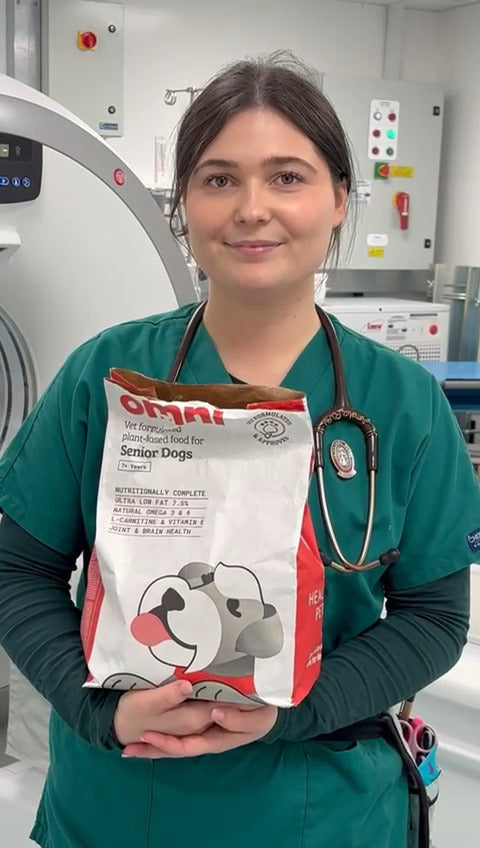Why Is My Dog Drinking So Much Water?

Polly from Essex asked our vets last week why her bulldog, Milo, was drinking so much water out of nowhere.
Now, there are a few reasons why Milo and other dogs appear to get particularly thirsty, so we decided to go through them in this article.
Our co-founder and Chief Vet, Dr Guy Sandelowsky, explains:
Reasons Why Your Dog is Drinking So Much Water
1. Your Dog Might Be Overheating
Dogs primarily cool themselves through panting, which is a normal response to heat. Panting is their way of sweating: water evaporates from their mouth, taking the body’s heat with it, and thereby lowering their overall body temperature on hot days particularly.
This is actually how much of the animal kingdom cools down - humans are strange because we sweat from our skin!
However, in order to keep themselves cool through panting, your dog needs to replenish their body’s water supply frequently.
How to Spot if Your Dog is Overheating
- Lethargy: Your dog may seem unusually tired or unwilling to move (even when you bribe them with “Walkies!”).
- Collapse: Severe overheating can cause your dog to collapse or become wobbly on their feet, perhaps losing coordination or stumbling into things.
- Wobbly or disoriented: Heatstroke can lead to weakness, stumbling, and confusion.
If you’ve suffered heat stroke before, remember how you felt and what symptoms you must have shown - your dog is not much different!
How to Help Your Dog Cool Down
- Provide a cool space: Ensure your dog has access to a shaded area and fresh water at all times. You can also offer cooling mats or fans to help them cool down faster.
- Pour cold water over your dog. This can help hugely in cooling them down quickly. (Do not cover them with a wet towel, as this can simply trap heat in.)
- Seek veterinary advice: If your dog shows any other symptoms of heat exhaustion, such as lethargy or collapse, contact your vet immediately, as heatstroke can be life-threatening.
2. Drinking Too Much Water Could Indicate Kidney Problems
Drinking lots and lots of water could also indicate that your dog has got underlying kidney problems and they are trying to drink water to flush the toxins out of their system instead, as their kidneys are no longer doing it for them.
Key Signs of Kidney Problems in Dogs:
- Increased urination frequency. If your dog seems to be going to the toilet all the time, it could be a sign that their kidneys are no longer working effectively.
- Lethargy.
- Vomiting. As toxins build up in their system due to kidney dysfunction or malfunction, your dog may vomit more in order to get rid of the nasty stuff their kidneys used to sort out for them.
What You Should Do:
- Seek veterinary advice: If your dog is showing the symptoms of kidney malfunction, it is important that you seek veterinary advice as soon as you can.
3. Diabetes Can Cause Thirstiness
Diabetes can cause excessive thirst because the body becomes unable to properly regulate blood sugar levels. This causes a buildup of sugars in the kidneys which the dog expels by urination. When this happens, it drags too much water out of the body, causing dehydration. The dog has to drink even more to make up for the lost water.
Key Signs of Diabetes in Dogs:
- Weight loss: One of the first signs of diabetes you may notice in your dog is sustained weight loss due to their inability to properly take in sugar from food.
- Increased frequency of urination: As explained above, dogs with diabetes frequently urinate in order to get rid of all the excess sugars blocking up their kidneys.
- Urinary infections: Sugar-rich urine from diabetic dogs provides the optimal environment for bacteria to proliferate in their bladder and urinary tract. As well as this, they will often have weakened immune systems and more frequent incomplete urination, resulting in more infections in total
- Increased appetite: Because diabetic dogs struggle to draw energy from their food due to the improper production of or response to insulin, they may feel like they are hungry all the time, even if they have eaten. This results in eating more than they usually would, as their cells feel like they are starving.
What You Should Do If You Think Your Dog Has Diabetes:
- Seek veterinary advice: Diabetes is a serious condition and needs proper management and medication. Thankfully, with veterinary attention, anybody can manage their dog’s diabetes. However, it cannot be easily managed without veterinary oversight, as you may be putting your dog at risk if you do not seek out the advice of your veterinarian.
Summary of Common Reasons for Excessive Drinking:
- Overheating: Look for signs of heatstroke such as lethargy, collapse, and disorientation. Provide a cool environment and fresh water. If symptoms worsen, seek urgent vet care.
- Kidney problems: Look for frequent urination, lethargy, and vomiting. Seek veterinary advice.
- Diabetes: Look for frequent urination, UTIs, and increased appetite. Seek veterinary advice.
When to Contact a Vet
You should contact a vet if:
- Your dog is showing the signs of kidney problems or diabetes.
- Your dog is throwing up and/or having diarrhoea.
- You have other concerns about your dog that are not covered in this article.
If you’re worried about your dog’s health, it’s always best to get professional advice. Book a free consultation with our vet team at Omni for expert guidance on what could be causing your dog’s increased thirst and how to manage it.
Thoughts from Dr Guy MRCVS
As dog lovers and guardians, it’s natural to worry about our furry friends, especially when they display abnormal symptoms that can’t be easily explained. That’s why, when I founded Omni, I knew that I wanted to keep vet consultation free and accessible at the heart of the business.
If you’re understandably worried about your dog, but you don’t think you need to take them to the vets urgently, I highly recommend getting some friendly, professional advice from one of our team.
Explore some of the frequently asked questions in our Ask a Vet series
Got a question for the Ask a Vet team?
Submit your question via email to woof@omni.pet. We’ll get back to you as soon as we can, and, if suitable, post the response here to help others, too!
Disclaimer: Our Video Vet Consultation service is limited because we are unable to perform a full physical examination of your pet. Our vets have no responsibility for the examination or other medical services provided during the Consultation.
Please note that our Video Vet Consultations do not replace traditional veterinary care, but can provide additional support. Based on the information you have provided and the symptoms you have described, the Vet will give you advice and an ongoing plan. Without a physical examination, we cannot provide a definitive diagnosis. If you are worried that your dog's condition is worsening, or you need additional support, please schedule another consultation, or see your registered vet.







 85 Great Portland Street, 1st Floor, London, W1W 7LT United Kingdom
85 Great Portland Street, 1st Floor, London, W1W 7LT United Kingdom